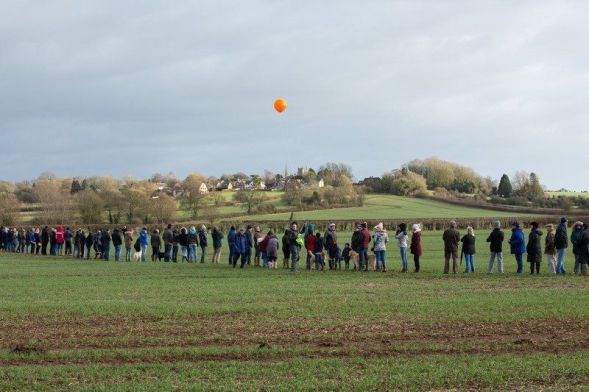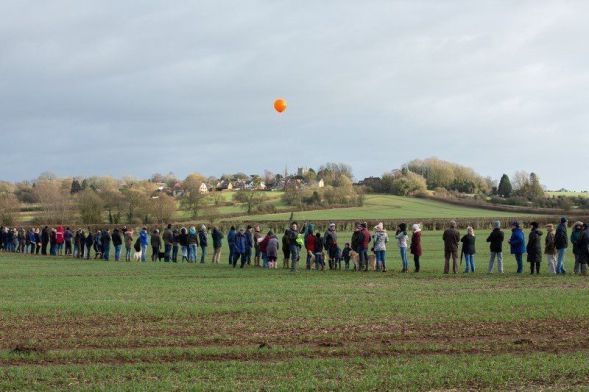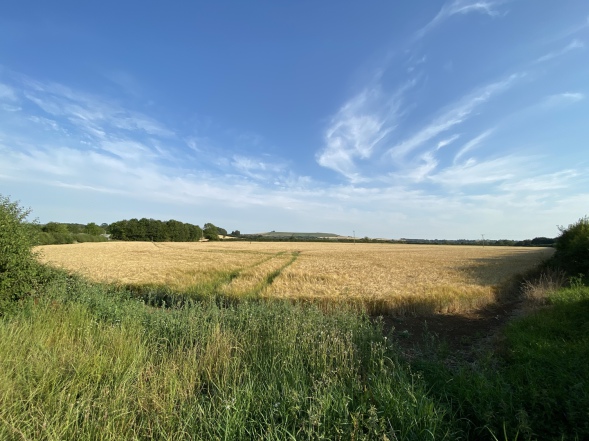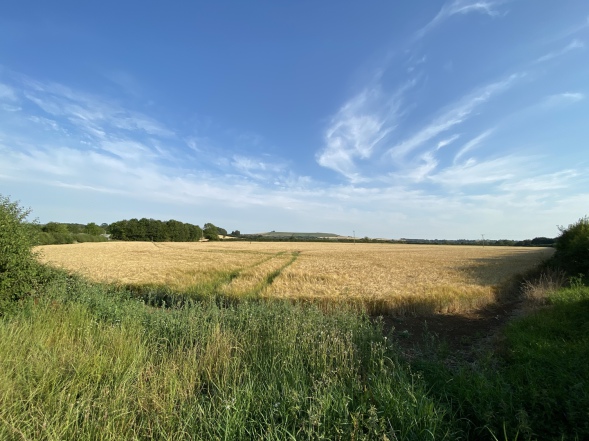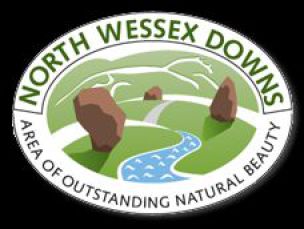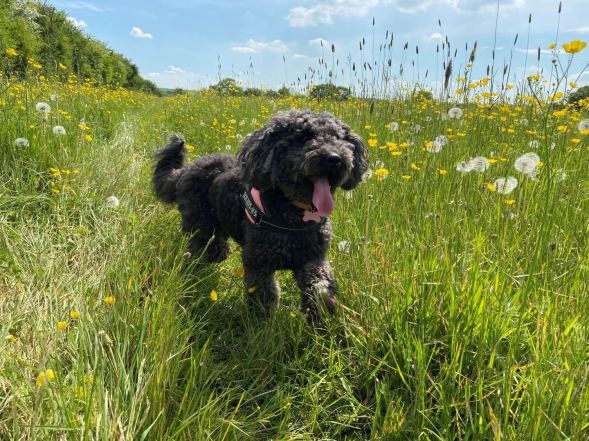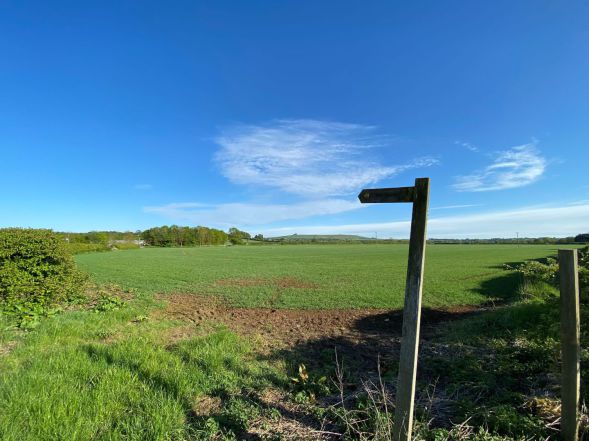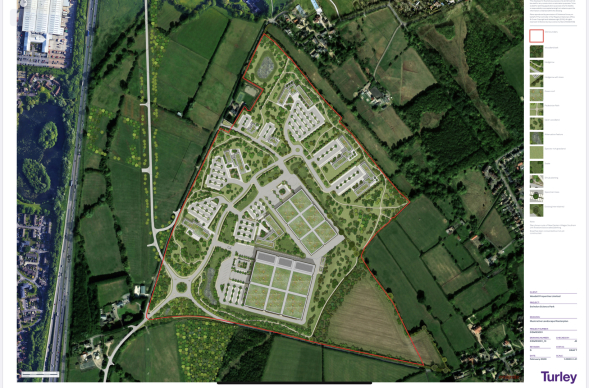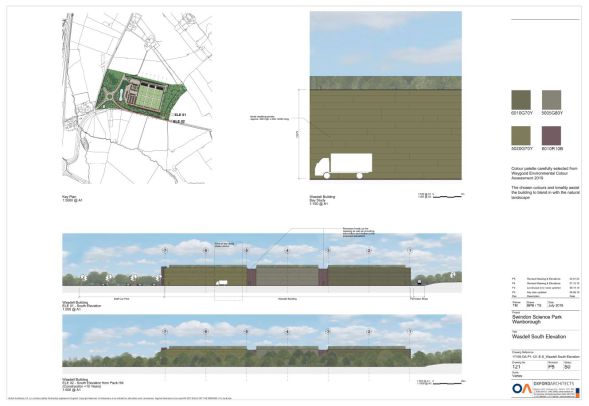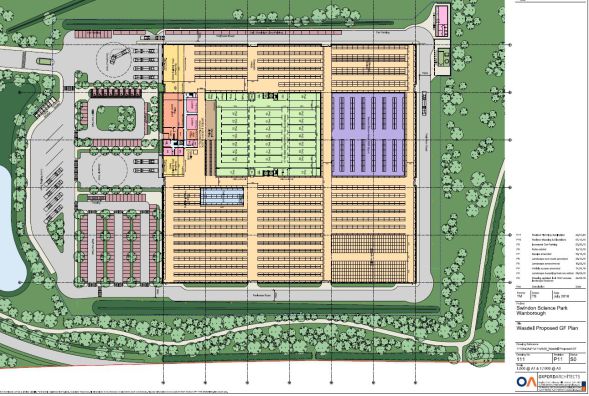S/OUT/18/1943 Inlands Farm
We won! Appeal dismissed. Well done to everyone involved and the decision noted particularly the AONB and protection of heritage assets and that the harm outweighed the economic benefit:
On the 24th January the Planning Inspector published his decision with the most relevant paragraphs copied below:
95. For completeness, there is a need too to carry out an overall planning balance. In my view, the environmental costs of the proposal, in relation to the character and appearance of the area, and the setting of the AONB, and the setting and thereby the significance of designated and non-designated heritage assets, are simply too great to allow them to be outweighed by the economic and other benefits prayed in aid of the proposals, even if those benefits are taken at their absolute highest.
96. Put very simply, a scheme of this sort would be a great economic opportunity for Swindon, and indeed the UK, but in my view, the
site that has been chosen for it is quite fundamentally the wrong one.
Final Conclusion
97. On that overall basis, it is my conclusion that the appeal should
fail.
My closing remarks submitted to the Inquiry the day before the main Public Inquiry closed.
Cllr Gary Sumner
The Ridgeway Ward
The Planning Inspector
C/O Helen Skinner
The Planning Inspectorate
Temple Quay House
2 The Square
Bristol, BS1 6PN
30th June 2021
APP/U3935/W/21/3269667
Dear Sir,
Closing remarks
I am sorry that I was unable to attend the ‘alternative sites’ round table due to a spell in hospital (where ironically, on the third floor of Great Western Hospital I have an outstanding view from my bed towards the appeal site, with the village of Upper Wanborough nestling atop the hill and with Lower Wanborough also visible). The features of the farmed field and pastures of the AONB are stunning and if this is not a key view of your visit, may I suggest it is included.
Having attended many of the sessions I have been impressed by the process and interesting disclosures, although as information has been disclosed the ‘Science Park’ is not quite the Pharma led iconic concept, but a theoretical tech park such as exists in many locations and which do not require a pharmaceutical packaging company to anchor them.
The case for ‘co-location’ was not well made in light of the above and as officers from SBC have confirmed (and I tend to agree) the ‘Technology Park’ element is highly speculative.
For example the Economic benefits on employment were provided by Wasdell, with no supporting evidence and were not challenged by Mr Amos, even though they suggested a density of jobs double the expected average for use. No evidence of any R&D evidence has been presented. The ‘LinkedIn’ profile for Wasdell is rather light on their ‘Science park’ specialism as attached and again this is relevant to ‘suitability’ to insist the proposals should sit side by side.
Both Robert Buckland MP and I have consistently stated that we are supportive of Wasdell but not in this location.
The two matters of potential users here are separate, but you sir are given the unenviable task of unpicking this.
Any ‘’packaging & distribution” company wants to be located close to main roads, on land found as cheaply as possible. For many years land promoters and planning & commercial agents have promoted farmland on the edges of town as the sites for industrial/housing growth. Through this time, older and established industrial sites are sidelined, yet often they are more sustainably located close to their workforce.
In statements, Wasdell talk of over 100 suppliers (8 wrote similar letters about possible interest to co locate – none are R&D centric businesses – supplier cluster at best) and clearly logistics (rather like the Honda site) are about large functional buildings in a convenient location. The current sites for their packaging business are by Junction 16 and the A419 at Groundwell.
In the time that they have been ‘seeking alternatives’ (and a swift new home for Wasdell) whilst promoting this unallocated greenfield site, Panattoni have delivered a bespoke 2m sq.ft building for Amazon at the allocated employment land at Symmetry Park (Great Stall West). This obtained detailed planning consent in less than a year and a year later is close to opening (this Autumn). This will feature advanced robotics, 1500 jobs and is a sustainable building across three mezzanine levels with associated offices and parking.
It is the role of a local authority to deliver suitable sites for employment and housing which Swindon has done and continues to do. It is not the role of the planning system to bend to the ‘it must be freehold’ wish-lists of the appellant and the addition of a speculative park of glass house type buildings simply means that they can steer eyes away from the main blocks. Phase One & two Wasdell buildings are not a ‘Science Park’.
A ‘Science Park’ (as we are obliged to keep calling it) may be situated in other, more sustainable locations in Swindon and as SBC officers pointed out Swindon has a new ‘Institute of Technology’ opening this autumn at North Star in Central Swindon, close to the station, close to the Universities who are clustering at the Carriage Works. Perhaps Wasdell are not the right anchor, evidence in examination certainly confirmed that the non packaging side of the business is tiny. CamSci did a report, but I’m not aware of them offering to build the required ‘hub’ speculatively and as it transpires it may not just be ‘Pharma’ led then perhaps they were the wrong experts to ask?
For 3-4 years Wasdell Packaging have used the planning process and threats of ‘leaving Swindon’, including definitive statements from their Chairman to this effect as well as his published promise not to appeal. Their PR representatives have placed many pieces in local and regional press citing that they wouldn’t appeal with others quoted saying the Honda site wouldn’t be available for 10 years.
Then they decided to appeal.
Alternative sites: The appellants have obfuscated when asked about why they couldn’t have a larger (taller) building elsewhere (to use less land) as Amazon have done with their 2m sq.ft building at Symmetry Park. They claimed during examination that ‘plant had to go on the roof’ for their sealed working environments. Then when this was questioned (as it is a detailed application for phase 1) they confirmed it would go on the side – I’m sure the inspector will wish to see that on the detailed plans.
The Amazon building contains solar panels the size of a football pitch. The Wasdell building has to use much of it’s roof area trying to hide its appearance in sedum. As was noted by other witnesses they have been forced to great efforts to disguise something which is alien to its location.
This brings me to the location:
The AONB boundary is Pack Hill.
The ‘setting of the AONB’ is acknowledged in National Planning Policy.
In choosing a greenfield site and then in placing the building the very largest green structure on the site immediately adjoining that AONB is rather dismissive of this part of the ‘National Landscape’ and the ‘setting’ not just a word but is a well established protection afforded to the AONB.
To suggest that it can be ‘concealed’ by newly planted trees (which will not be mature for 15-20 years) and which by their nature are without leaves for six months was also a point questioned and not convincingly answered – nor was the fact that the site is on a hill and clearly that affects its appearance/massing.
Swindon Borough Council are consulting with the public on ‘art installations’ for the planned New Eastern Villages along the route of the Southern Connector Road (a road solely to serve around 1/3rd of the planned residential villages to the North of Wanborough). The largest landscape installation is at the bottom of Pack Hill adjoining the SCR roundabout (with the two Community Forest planted fields within the AONB directly behind) and this includes a series of spiral mounds from which people can take in the landscape whilst signage for the AONB is proposed. At the top of these (if we are very unlucky) both residents and visitors will have a view of the industrial landscape proposed which will operate as the appellants stated 24//7 with attendant noise and light pollution.
The talk today of the Honda site was dismissed by Mr Gregory (who has also been promoting the sale of two adjoining plots of land within the AONB at the bottom of Pack Hill (the signs are still visible) as not available.
The application from Panattoni for an opinion on an environmental impact assessment shows their intent and they have briefed local Ward Councillors on their plans, which are indeed genuine and ambitious. Honda closes next month and the most sustainable proposition for employment growth is that site.
The Government white paper proposes to ensure communities welcome good growth. That the planning system doesn’t stifle, but allows that good growth. However what it is not intended to do is to over-ride planning policy to deliver unplanned growth when sufficient land for ambitious growth is already proposed.
Both David Dewart and Ed Snook made perfectly valid points on planned growth. Swindon has allocated (including the Honda site) ambitious plans for economic growth and this was demonstrated with the Amazon application, that good growth on allocated sites is supported and numerous approvals for over half the the NEV housing sites already made.
In cross examination the appellants Counsel was keen to stress that Swindon Borough Council hadn’t allocated land for a ‘Science Park’. This tactic is to say that something of which they have no experience of ‘curating’ is an essential component in the siting of their two very ordinary industrial buildings, lorries and car parks.
There are very many credible and available alternative sites within Swindon, particularly the Honda site which is shown to be actively promoted and already within the planning process despite Honda leaving next month. It is (as with Amazon) far more likely that we will see new occupiers on this site long before a ‘Science Park’ and Wasdell appear at Inlands Farm.
Over supply of employment sites leads to sites being ‘flipped’’ to residential and having been a resident in the village for over 20 years I have seen how residents (whilst having initial reservations) can accept planned growth in the right location accompanied by suitable facilities and mitigation.
If you have visited the village you will see that this speculative application is not welcomed and the poorest quality housing developments in Swindon (and most unwelcome) are those won on appeal with land value rather than quality as the driver.
The size of the Southern Connector Road was a fine balance as it didn’t require a dual carriageway and is designed for residential use as it does not promote through traffic – ending at a Primary School in the proposed ‘Lotmead’ village. If residents start queuing behind the additional traffic they will ‘rat run’ which is a policy requirement to prevent.
The time this site will take to deliver from scratch could be lengthy. We already know that utility supplies are stretched and that a new site will require a water supply in competition with the planned growth at NEV, new gas and electric connections which do not exist (has capacity been shown?) and after all of this the appellant had definitely not chosen an easily deliverable option yet the pressure has been on constantly to find Wasdell Packaging a new home.
I sincerely hope that for myself and the residents I represent that this appeal is refused.
They have been extremely tolerant of massive planned growth to the north of the village (the 8,000+ homes and 40 hectares of employment land) and in return they were given the promise of the Planning Inspector of the 2015 Local Plan as an element of protection, the ‘area of non-coalescence’ to prevent the village being joined to the urban area. Because these hilltop villages have special characteristics, noted many times already I will not repeat the Heritage witnesses statements).
The harm outweighs the speculative benefits – both elements of this application can be located elsewhere and do not have to co-locate.
Yours sincerely
Cllr Gary Sumner
The Inquiry started today (15th June 2021).
Key points:
The inspector introduced the plan for the three week Inquiry.
The QC for Wasdell made his opening speech followed by John Warr for SSPC and then the QC for Swindon Borough Council.
In the second session 'Interested Parties' and members of the public were invited to speak. I spoke first and confirmed that I was also representing Robert Buckland MP (my comments are added below).
Dave Hayward spoke for the Parish Council and Gordon Wilson spoke for Liddington Parish Council.
The QC for Wasdell asked me some questions relating to how I viewed the site in my Cabinet role and I confirmed that I remained in favour of allocated sites and was against Inlands Farm - a fact made very clear by SBC in their opposition to the application.
The later session was then given to the first expert witness - David Dewart a Town Planner from SBC who was questioned by SBC's QC and then questioned at length by the Wasdell QC. This questioning continues tomorrow.
SSPG as a 'Rule 6' party are attending every day and have a couple of advocates/witnesses to assist.
I will be speaking in the third week on 'alternative sites'.
My opening remarks:
I am Gary Sumner and I have been a resident in Wanborough for some twenty years. I am the Borough Councillor for the Ridgeway Ward and I am speaking here today in that role. I have also been asked by Robert Buckland MP to state that I speak on his behalf.
I have been the Cabinet Member for Strategic Planning at Swindon Borough Council for the past three years, working on the Local Plan review with communities across Swindon finding the most appropriate places for growth of housing and employment.
I was previously a Parish Councillor in Wanborough and Chairman of the Parish Council.
In that role I attended the Examination in Public of the current local plan.
I was involved in discussions with SBC during the preparation of that plan to move the employment allocation of the NEV to the much more appropriate site at Symmetry Park on the A420.
There was considerable concern at the time that the allocation of land for some 8,000 new homes would have on the village of Wanborough and as a result an area of ‘Non-Coalescence’ was proposed to respect and protect the village of Wanborough from being joined to the urban area of Swindon.
The Southern Connector Road has been designed for a very specific purpose – not as the entrance to an employment site, but as a discrete single carriageway road with field entrances, a safe cycle route and pavement to connect small new villages within the New Eastern Villages. Do not be misled that it is a strategic road – it ceases in the middle of the NEV and is not designed for through journeys.
The work on this route has removed some established trees at the Commonhead junction of Pack Hill and this work has made it very clear how the hilltop village of Upper Wanborough sits within the landscape.
Both Robert Buckland and I are clear that we support Wasdell Packaging and their business, but we both firmly believe that this is a highly inappropriate and sensitive location.
Other sites are available for employment growth in Swindon which is acknowledged in the Alder King report for the appellant.
Repeated reference has been made to Wasdell and their short term leases on sites in Swindon and they have made it clear that this was a driver for their business. Now it appears to be the Science Park.
Planning and the choice of sites is important and unplanned growth leads to viability issues with properly allocated employment sites.
Evidence will be shown that there are alternative sites and that if the appellant wanted a solution for their business needs, as they have said many times in the press over recent years, they would not have chosen an unallocated greenfield site, protected by a planning policy against coalescence, immediately adjoining a nationally protected landscape.
The residents of Wanborough and nearby villages are not ‘nimbys’ – in the past two decades they have been surrounded by land promotion and development proposals and have accepted over 8000 homes (over half of which are being built in the Parish of Wanborough), 40 hectares of employment.
The Borough Council and Planning Inspector for the current local plan offered the protection of this land to guarantee that the villages would not be consumed by urban growth.
I urge that this appeal is dismissed as inappropriate for both Wanborough, the North Wessex downs AONB and to reassure residents across Swindon that growth should be in allocated locations if Local Plans are to mean anything.
Cllr Gary Sumner - The Ridgeway Ward
From August 2020..............
We won!
The Wasdell application for an industrial /Science Park at Inlands Farm was firmly rejected at tonight's Planning Committee meetings.
More in the next day or two but what a reward for the efforts of SSPG, friends, supporters and all in rejecting this completely inappropriate use of a site adjoining the AONB and in an area designated (By SBC) as an area of Non Coalescence.
Victory for our villages and Planning system today.
I regret the threat of moving jobs elsewhere and hope that Martin Tedham speaks to us to see what can be done now to keep him in Swindon and support his Swindon employees whom he values so highly - he has our contact details and we will support him.
LATEST NEWS: This unwelcome Planning Application will go to a
PLANNING COMMITTEE 25th AUGUST 6pm!
I have opposed this application as completely wrong.
I will speak to oppose it on the 25th as Ward Councillor and I believe that it does not offer the benefits promised, it contravenes Local and National Planning Policy and with the latest updated application is even more unacceptable. As one of the professional comments notes - this is an industrial park with a 'science park' bolted on...
The 'employment land study' submitted for the applicant is embarrassing and genuinely makes this application less credible.
There isn't a site in the country which could meet the criteria.
Gary Sumner
Your Ridgeway Ward Councillor
Comments submitted by SBC's Landscape Architect on the Inlands Farm Application:
EN5.1 Summary:
My previous comments remain unchanged: ‘The application depicts a development of substantial scale, in a sensitive rural location, which would create an unacceptable urbanisation of existing countryside.
This would be detrimental to the rural setting of Wanborough and the protected setting of the North Wessex Downs Area of Outstanding Natural Beauty that abuts the site to the south, and the planned NEV.
Both phases of the application, or either phase if considered individually, are markedly incongruous in this location, presenting harmful and overwhelmingly adverse visual impacts.
The applicant has incorporated various techniques to minimise this impact, but visual mitigation can only achieve limited results as clearly shown by the submitted 3D views.
Comments submitted to the revised application at Inlands Farm by SBC's Conservation Officer:
Conclusion: I have given consideration to the preservation and enhancement of the character and appearance of the conservation areas and the significance of designated heritage assets, including their setting.
On balance, I do not consider that there is ‘clear and convincing’ justification for the harm caused as required by Paragraph 194 of the Framework.
I have concerns from a conservation perspective regarding the principle of such a development and its impact upon the character and appearance of the conservation area and the setting of designated heritage assets.
In this case I would recommend refusal on the following basis:
The proposed hybrid application which contains full application for 33,507Sqm of industrial use and an outline application for 48,681 Sqm, a result of its siting and location on an open parcel of land within the open countryside would result in an incongruous, prominent form of new development that would have an unacceptable urbanising effect by way of visual intrusion and unacceptable encroachment into the rural landscape setting which results in harm to the setting and context of surrounding designated and non-designated heritage assets.
The proposal would therefore fail to provide a scheme which 2 Paragraph: 013 Reference ID: 18a-013-20190723, Revision date: 23 07 2019 Conservation Comments Masterplanning, Design & Conservation Team Planning Department, Swindon Borough Council Planning Ref: reinforces local distinctiveness, preserves or enhance the tranquillity, amenity and traditional quality of the landscape setting and fails to make a positive contribution to the locality which would outweigh the harm caused.
The proposal is therefore, contrary to the duties under S66 and S72 of the Planning (Listed Buildings and Conservation Areas) Act 1990, Local Plan Policy EN5, EN10 and the heritage policies of the Framework.
Normally I would seek to suggest amendments which may overcome any objections, however on this occasion, the principle of such a scheme is clearly inappropriate from a conservation perspective.
Whilst the scheme is presented as a ‘science park,’ in reality after Phase 1 and 2 were implemented, the science park component would contain 32,281Sqm of floorspace, roughly 40% of the entire floorspace. Realistically the site will be an industrial site which takes up 60% of the use with an ancillary ‘science park’.
As the proposed 'Science Park' immediately adjoins the Area of Outstanding Natural Beauty I thought I would share a useful extract from:
'NORTH WESSEX DOWNS AONB POSITION STATEMENT'
on 'SETTING'
(Development Affecting the Setting of the North Wessex Downs AONB)
1. Areas of Outstanding Natural Beauty (AONBs) are designated by the Government for the purpose of ensuring that the special qualities of our finest landscapes are conserved and enhanced. In planning policy terms they have the same status as National Parks.
2. The primary purpose of the North Wessex Downs AONB is to conserve and enhance the natural beauty of the AONB. The AONB also has secondary purposes to increase awareness and understanding of the special qualities of the AONB, to take account of the needs of agriculture, forestry and other rural industries and to foster the social and economic well being of local communities and those who live and work in the area.
3. The setting of the North Wessex Downs AONB can be explained as being the surroundings outside the AONB and although outside its boundary its extent is not fixed and may change over time. Elements of a setting may make a positive or negative contribution to the AONB, it may affect the ability to appreciate that significance or may be neutral. For the purposes of spatial planning, any development or change capable of affecting the significance of the AONB or people’s experience of it can be considered as falling within its setting.
4. The surroundings of the North Wessex Downs AONB are also important to its landscape character and quality. Views out of the AONB and views towards or into it from surrounding areas can be very significant. Development proposals that affect views into and out of the AONB need to be carefully assessed to ensure that they conserve and enhance the natural beauty and landscape character of the AONB.
My comments as Ridgeway Ward Councillor have been submitted on the application at Inlands Farm, Wanborough - proposal for an industrial development and 'Science Park'
Gary Sumner
Blenheim
Kite Hill
Wanborough
Swindon
SN4 0AW
Ed Snook
Planning Officer
Swindon Boroough Council
Euclid Street
Swindon
05 June 2020
Dear Ed,
Re: S/OUT/18/1943
I am objecting to this revised application as a resident of Wanborough and as the Ward Councillor for Wanborough.
Planning Policy: The site remains outside of the adopted Local Plan (for development purposes) and was specifically rejected from inclusion in the Draft Local Plan, which has been through both the Regulation 18 & 19 Statutory Consultations.
Part of the Local Plan review process was the SHELAA (Strategic Housing & Economic Land Availability Assessment) and this site was expressly rejected in that process as unsuitable.
The Draft Local Plan has identified sufficient land for the economic needs of the Borough and they have also taken steps to safeguard the employment use of the Honda site which will close in July 2021.
No Planning Policy can cater for the very specific whims of an applicant, which in this case have been drawn so tightly that only one site could every fit their criteria.
For Swindon Borough Council to reject their own Local Plans would be highly unusual. This site was designated as an ‘Area of Non-Coalescence’ at the 2015 ‘Local Plan Inquiry’, to mitigate the 8000 home ‘New Eastern Villages’ development. That planned allocation already included a 40ha employment site (which incidentally this applicant rejected due to tenure) but is likely to be built and occupied within 18 months.
Whilst I am very supportive of the applicant and his business, their use is a small part of this site (although highly visible). The contrived ‘needs list’ and the ‘alternative sites’ study carried out by the landowner’s agent (rather than an independent and objective third party with suitable specialist knowledge) is meaningless.
It is designed around giving one possible answer. Wasdell require a much smaller site for their business. That need is not objectively assessed in the application.
As this proposal is not for housing, our Local Plan can be considered ‘up to date’ and is fully relevant in assessing this application.
Phase 1: The application suggests long term maturity of planting, but it is undeniable that the ‘setting’ of both the Conservation area of the village of Upper Wanborough and the rural setting to the North Wessex Downs AONB will be changed forever.
This is a principle issue as the site slopes up towards Upper Wanborough and the AONB and therefore the views from and to these protected features will be a key issue.
Because the applicants have chosen to give certainty in only one aspect – ‘Phase 1’ then that is the visual impact we must address first.
The Phase 1 building will be a dark mass encircled by a HGV access road around the building - meaning that lighting (when viewed from the AONB and the Conservation area will be an issue) as well as noise.
Planting to the western main approach would be new. This will not hide the building for decades and that will lead to the alien building concealing the hilltop village.
Access: The application claims early delivery of the roundabout section at the intersection of Pack Hill and the Southern Connector Road. This road is already fully funded and the section within the application boundary was already being delivered following the CPO Inquiry.
The ‘claim’ to be delivering a cycle path is untrue as it already being delivered by the SCR project and fully funded.
The Southern Connector Road is a strategically well-planned single carriageway road with a soft edge and with cycle paths and pavements and is only planned as an access for around 1/3rd of the residential only traffic of the New Eastern Villages.
Any additional burden on this road may lead to drivers choosing alternative routes in contravention of the Borough policy to minimise rat running in Wanborough and nearby villages.
A 24/7 distribution and manufacturing warehouse added to the SCR will lead to many additional vehicle movements which make both the cycling and pedestrian connectivity being less attractive. Delays at Commonhead roundabout as a result of both employee traffic (the applicant suggests a doubling of existing employees to 1200) on top of the 230 suppliers delivering in and the 85% of deliveries out heading to Heathrow for export. That is only phase 1.
This proposal: The ‘Science Park’ is an Outline Application, but the attractive ‘green spaces’ are contained largely within that area. Views from the Marsh towards the AONB or from the Southern Connector Road are only mitigated in that 2nd phase outline which may never be delivered.
CAM-Sci have delivered a glossy report which discussed possibilities – they have not been commissioned to deliver the Science Park themselves and alternative Science Parks away from educational institutions such as Porton Down have required tens of millions of pounds of subsidy to deliver any notable employment.
About the location: Inlands Farm is established good arable farmland, rising in the East to the Upper Wanborough Conservation Area and to the South ‘Pack Hill’ which forms the boundary with the Area of Outstanding Natural Beauty (AONB). The AONB as well as the 'setting' of the AONB have national protection. For this reason, applications close to Lydiard House (for example) have been refused because often the 'setting' is as important as the designated asset.
The 'setting' of the hilltop village and Conservation Area of Upper Wanborough has designated significance (as evidenced in previous appeal decisions) and few people would argue that the village (when viewed from the area around 'Great Moorleaze' at the entrance to the AONB) would disappear behind the industrial building and its attendant lighting, noise and infrastructure. The Grade 1 listed church at St Andrews is the most prominent part of the skyline as well as the more distant Liddington Hill and Castle.
About 80% of the site sits in the Area of Non-Coalescence designed to protect Wanborough, the AONB and other villages from coalescing with Swindon. It is an open landscape with few major trees for example meaning that anything which is built will be obvious.
Applicants Landscape Plans: The Landscape plans indicate that in the 40m strip of land between the AONB and the building there will be a road, two sections of tree planting, a ditch and an ‘attractive’ pedestrian route.
The problem with trees required to hide a 14.5m building are that they grow in height and width – this means that the attractive pathway will be in shade and will need to be lit as well as the vehicular access – all adding to light pollution. They also are not in leaf all year round.
The landscape assessment specifically references viewings out from the Conservation area but do not address the views towards nor the ‘setting’.
The applicants own ‘Landscape & Visual Amenity Report states:
• Two adjoining blocks of recently planted woodland on the south side of Pack Hill (opposite the Site) would mature to form a new woodland block on the northern edge of the North Wessex Downs AONB. This will provide substantial enclosure to the south side of the Site and separation from the AONB.
What this ‘expert report’ fails to note is that those woodland blocks ARE the AONB.
Flooding: The site is notable for ground water flooding. Water flows across the land resulting in considerable fast-moving flows at the entrance to Inlands Farm and which discharge into the roadside ditches heading North along The Marsh.
Flooding increased in recent years due to less deep ploughing of the land and it is difficult to see how the ‘developed’ site would better this situation.
The Environment Agency notes that they do not record surface water flooding which occurs across this site and we have photographs from this year which inform.
Water Supply & Sewage:
In a belatedly updated comment Thames Water confirms there is insufficient FOUL WATER capacity to serve a commercial building larger than 625sq.m (The Phase 1 proposal is 33,000sq.m).
They also confirm a water supply deficiency for Phase 1 (and any additional buildings beyond 23,000sq.m
For the Planning Authority the consideration should be whether this identified deficit in a basic facility to serve the development will make other Phases of the NEW EASTER VILLAGES unviable in the short term as the capacity identified for residential development may be taken away by this un-planned development.
POLICY DETAIL:
1) This site is not allocated for development - housing or employment. It is largely with the SBC designated 'Area of Non Coalescence' and the 'setting' of the North Wessex Downs Area of Outstanding Natural Beauty'
Policy NC3 in the Local Plan states (bullet E): The character and identity of Wanborough, Bishopstone and Bourton will be protected by a principle of non-coalescence between the settlements. The land between the New Eastern Villages site boundary and the existing villages shall remain part of the countryside. However, small scale development within this area, as defined on the Policies Map, will be permitted where it retains or enhances the existing character of the countryside and involves the re-use, conversion or extension of existing buildings at a scale appropriate to their location, in accordance with the criteria specified in Policy DE1; or is an essential requirement directly related to the economic or social needs of the rural community.
2) Policy EN2 in the Local Plan states 'Swindon Borough is set within a beautiful landscape context including the North Wessex Downs Area of Outstanding Natural Beauty'.
3) Policy EN5 in the Local Plan states 'The North Wessex Downs Area of Outstanding Natural Beauty (AONB) is a nationally recognised area of landscape protection. Proposals within the Borough which are within and or abuts the North Wessex Downs AONB must accord with relevant criteria set out in the AONB Management Plan and paragraph 115 and 116 of the NPPF. Proposals outside the AONB should not adversely affect its setting.'
Policy EN5 further states 'In meeting the requirements of EN5a, applicants for development should demonstrate how they have taken into account Landscape Character Assessments and assessed the potential impact of the proposal upon the following attributes of the landscape: existing landscape form, features, topography and character; the contribution of the landscape to biodiversity and wildlife; local geology and geo-diversity; views, visual amenity and the landscape setting;
Biodiversity - locally distinctive and characteristic pattern and species composition of natural features such as trees hedgerows, woodland field boundaries watercourses and water-bodies;
Geology - locally distinctive and characteristic landforms and topographical features throughout the Borough such as locally important views, visually sensitive sky lines, ridges and valleys;
Views both in and out - visually sensitive skyline, geological and topographical features; and the separate identity of settlements and the transition between man-made and natural landscapes at the urban fringe.
I would like to remind those considering the application that SBC has obligations regarding the AONB as part of ‘our’ management plan – which we are obliged by Government to produce and to which we should have due regard in considering applications both within, and in the setting of the AONB.
NPPF policy on AONBs:
116. Planning permission should be refused for major developments in these designated areas except in exceptional circumstances and where it can be demonstrated they are in the public interest. Consideration of such applications should include an assessment of:
• the need for the development, including in terms of any national considerations, and the impact of permitting it, or refusing it, upon the local economy;
• the cost of, and scope for, developing elsewhere outside the designated area, or meeting the need for it in some other way; and
• any detrimental effect on the environment, the landscape and recreational opportunities, and the extent to which that could be moderated.’
Has the duty to have regard to the statutory purposes of AONBs to ‘conserve or enhance the natural beauty of their area’ been carried out? This often-overlooked legal requirement is to consider whether an AONB will be ‘enhanced’ by a proposal as well as ‘conserved’ by it.
The North Wessex Downs AONB lies to the south, partly within Swindon Borough. Its landscape is predominantly a chalk land landscape of scarp slopes and moulded dip slopes that reflects the underlying chalk geology.
National guidance has confirmed that great weight should be given to conserving landscape and scenic beauty in AONBs which have been confirmed as having the highest status of protection in relation to landscape and scenic beauty.
AONBs are protected under the existing statutory requirements of the Countryside and Rights of Way Act 2000, specifically under Section 85 it is a legal duty for all relevant authorities to have regard to the primary purpose of AONBs to conserve and enhance the natural beauty of the area.
The potential for harm on the setting of the area from large-scale urban extensions is substantial. Any new uses or development proposed outside but within the setting of the area should consider the North Wessex Downs AONB Position Statement on Setting.
Proposals should include detailed measures to mitigate against harm on and into the area. Forms of mitigation may include strategic landscape buffers, restrictions on building heights, care over massing and scale, care over roofscape design, or avoidance of development in the most exposed locations.
The North Wessex Downs AONB Management Plan includes a policy paper on ‘settings’. The management plan is likely to be a material consideration in planning decisions.
The AONB ‘Setting Position Statement’ couldn’t be clearer - Paragraph 5 copied below it is difficult to see how each of these is not relevant to this application:
5. Examples of adverse impacts on the setting of the North Wessex Downs AONB could include:
• development which would have a significant visual impact on views in or out of the AONB;
• breaking the skyline, particularly when this is associated with developments that have a vertical emphasis and / movement (chimneys, plumes or blades for example);
• loss of tranquillity through the introduction or increase of lighting, noise, or traffic movement or other environmental impact like dust, vibration, spatial associations and historic relationships; • introduction of abrupt change of landscape character; • loss of biodiversity, particularly if of habitats or species of importance to the AONB;
• loss of features of historic and natural landscape interest, particularly if these are contiguous with the AONB;
• change of use of land such that to cause harm to landscape character; and
• development individually or cumulatively giving rise to significantly increased traffic flows to and from the AONB, resulting in loss of tranquillity and erosion of the character of rural roads and lanes; • Increase in air and water pollution.
NPPF paragraph 115 requires that in any decision “great weight should be given to conserving landscape and scenic beauty” in AONBs.
This applies not only to developments proposed within an AONB but if proposed in its setting such that the AONB would be affected.
The height of the hurdle to be crossed by the ‘great weight’ requirement is a matter of judgement in individual cases, but the High Court has clarified that it must be taken seriously.
Would the development be ‘major’ development within the AONB for the purposes of applying NPPF paragraph 116? I believe it would be.
If the development is ‘major’, permission should be refused unless the two requirements in paragraph 116 have been met. These are that there are ‘exceptional circumstances’ to justify permission and that the development is ‘in the public interest’.
An interesting extract from the CamSci Report:
Swindon Science Park Operations Model: The most successful science parks in the UK are those in single ownership with an estate-wide operations strategy that integrates development and facilitates delivery of a single vision.
This model is most common where the landlord funds development (directly or indirectly) and the tenant entity leases premises from the landlord. To retain control and maintain the enduring vision of the project, as well as to maximise capital value, this model grants only ground leases other than in exceptional circumstances.
My Comment: This is the model which Wasdell identified as a block to them moving to somewhere like Symmetry Park where ‘freehold’ and flexibility in design’ were not available.
As a resident of the village and as the elected representative of the residents of Wanborough, and the area in which this scheme is proposed I would urge refusal.
The site is not in accordance with local or National Planning policy, genuine alternatives are available if an employer is open to those alternatives. In this case we are on one hand being shown and employer who is undoubtedly important and on the other a speculative application to turn unallocated farmland into development land.
Finally, I reserve the right to make additional comments as corrected documents are added to the planning portal and critical matters including Highways modelling remain outstanding.
Yours sincerely,
Gary Sumner
Ridgeway Ward Councillor & Resident.
Please check our 'NEWS PAGE' for other items

